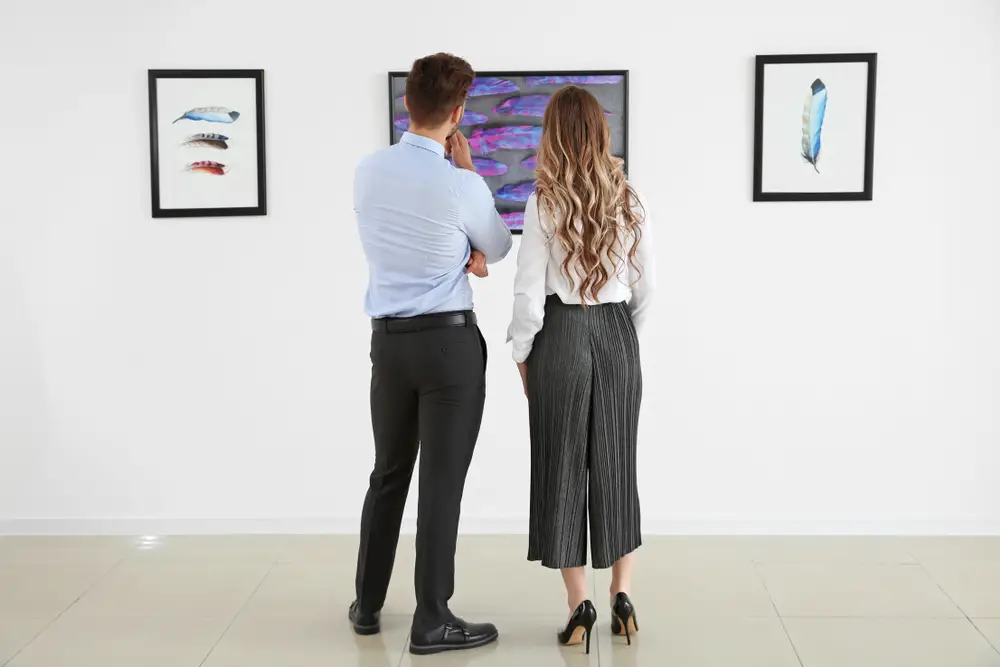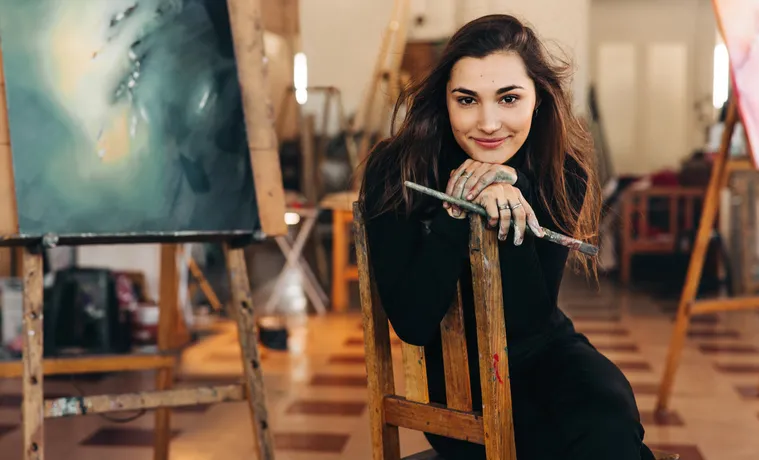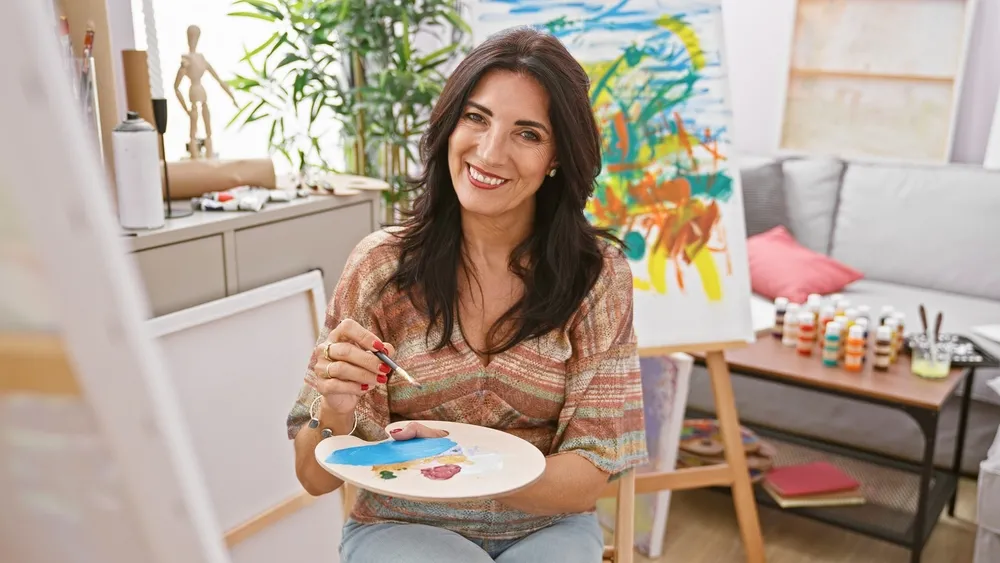Investing in art can be an exhilarating journey, transforming your walls into a gallery of both beauty and financial potential. Whether you’re a seasoned collector or just starting, the art world offers endless opportunities to blend passion with investment. But how does one navigate this vibrant market and end up with masterpieces that could potentially appreciate in value? Let’s explore the smart ways to invest in art and have millions hanging on your walls.
1. Start with Emerging Artists to Get Ahead of the Curve

Venturing into the art world with emerging artists can be a lucrative strategy. These artists, often fresh out of art school or early in their careers, have yet to gain full recognition. This means their works are typically more affordable compared to established artists. Engaging with emerging artists not only supports new talent but also offers a chance to acquire artworks that can appreciate significantly. According to Maddox Gallery, emerging artists are increasingly capturing collectors’ attention, making it a good time to invest in their works. Read more about how to spot emerging artists here.
Buying from emerging artists can also be more personal and fulfilling. You’re able to engage with them directly, learning about their inspirations and future projects. This connection can enrich your collection and ensure you are part of their journey from the start. While not every piece will turn into a financial jackpot, the potential to identify a future star adds an exciting element to your collection.
2. Understand the Importance of Provenance

Provenance refers to the history of ownership of a piece of art. Knowing a piece’s provenance can significantly affect its value and authenticity. When purchasing art, especially older works, always ask for documentation that traces its ownership. This helps in verifying its authenticity and reduces the risk of acquiring stolen or counterfeit art. According to Sotheby’s, provenance plays a crucial role in the market value and desirability of a piece.
Furthermore, a well-documented provenance can add a fascinating story to your art collection, enriching your appreciation of the work. It offers insights into the artwork’s journey over time and its cultural significance. Provenance can also reveal previous owners who might have been notable collectors or historical figures, adding an extra layer of prestige. Therefore, ensuring solid provenance is not only a smart investment strategy but also a way to deepen your connection with your collection.
3. Build Relationships with Art Dealers and Galleries

Networking with art dealers and galleries can open doors to exclusive opportunities. They can provide insider knowledge and access to works that aren’t publicly available. Developing these relationships helps you gain insights into market trends and upcoming talents. Art dealers can also advise you on the potential financial growth of specific artworks. According to the Art Dealers Association of America, professional dealers can guide you in acquiring works with significant investment potential. Discover how to choose a reputable art dealer here.
By building these connections, you’re positioning yourself to be in the loop for exclusive showings and private sales. Consistent interaction with dealers and galleries can also enhance your reputation as a serious collector. This, in turn, can lead to more personalized recommendations and offers. Moreover, a strong relationship with a dealer can mean they keep you in mind for future deals that align with your interests and investment goals.
4. Diversify Your Art Investments Across Mediums

While paintings are the most traditional form of art collecting, it’s wise to diversify your collection across different mediums. Sculptures, photography, digital art, and even textiles can all offer unique investment opportunities. Each medium has its own market trends and appreciation potential, which can enhance the overall value of your collection. By exploring various forms, you’re not only broadening your aesthetic horizons but also mitigating risk. If one medium takes a downturn in market value, others might still hold strong or even increase.
Moreover, diversifying your collection can make it more dynamic and intriguing. It allows you to explore different styles, techniques, and cultural influences. Each medium brings its own narrative and context, enriching your understanding and appreciation of art. A diversified collection is also more likely to appeal to a broader audience, increasing its potential resale value. Embrace the diversity that the art world offers and watch your collection grow in both financial and cultural wealth.
5. Attend Art Fairs and Auctions Regularly

Regular attendance at art fairs and auctions is key to staying connected with the art market. These events are hotspots for discovering new talents and acquiring works from a wide range of artists. They provide a unique opportunity to see a vast array of artworks in one place, making it easier to spot trends and potential investments. Engaging with artists, dealers, and other collectors at these events can also enhance your understanding of the market. Each interaction can provide insights into valuation and the art community’s dynamics.
Art fairs and auctions also allow you to witness the competitive nature of art buying firsthand. Bidding wars can offer a glimpse into the current demand for particular artists or styles. Additionally, attending these events helps you build a network of fellow art enthusiasts and professionals. This network can be invaluable for sharing information and opportunities. So, make it a habit to attend these events to stay informed, inspired, and invested.
6. Follow Market Trends But Stay True to Your Aesthetic

While market trends can guide your investment choices, it’s crucial to maintain your personal aesthetic. Art is a reflection of your tastes and passions; it should resonate with you on a personal level. While some collectors chase the popular or the trendy, investing in what you love will always be more rewarding. Staying true to your preferences ensures that your collection remains a source of joy, regardless of its financial value.
However, being aware of market trends can help you make informed decisions. It allows you to balance your passion with potential financial gain. You might discover that your taste aligns with emerging trends, offering a double benefit. Ultimately, blending market awareness with personal preference will make your collection uniquely valuable and satisfying. This approach ensures that your walls are adorned with pieces that speak to both heart and wallet.
7. Educate Yourself Continuously About Art

Continuing education in art is essential for making informed investment decisions. The art world is vast and constantly changing, with new movements, technologies, and artists emerging regularly. Attend lectures, take courses, and read extensively about art history, contemporary trends, and market analysis. The more you know, the better equipped you’ll be to spot valuable opportunities and avoid pitfalls. Education can also deepen your appreciation and enjoyment of the art you collect.
By staying informed, you’re also able to engage more meaningfully in discussions with other collectors and industry professionals. This knowledge can enhance your reputation and credibility within the art community. Furthermore, understanding the factors that influence art valuation can assist in identifying undervalued works. So, never stop learning about art – it’s a lifelong journey that enriches both your collection and personal growth.
8. Understand the Role of Art Advisors

Art advisors can be invaluable allies in building a high-value collection. They offer expert guidance, helping you navigate the complexities of the art market. An advisor can provide insights into emerging artists, market trends, and potential investment opportunities. They work closely with you to curate a collection that aligns with your tastes and financial goals. Hiring an art advisor can be particularly beneficial for newcomers to the art world, providing a level of confidence and security in your purchases.
Advisors also have access to a network of galleries, dealers, and auctions, often leading to exclusive opportunities. They can negotiate on your behalf, ensuring you receive fair prices for your investments. Additionally, an art advisor can offer advice on maintaining, insuring, and managing your collection. While hiring an advisor comes with a cost, their expertise can significantly enhance the quality and value of your collection over time. Consider them as a partner in your art investment journey.
9. Consider the Potential of Digital Art

Digital art is a rapidly growing segment of the art market, offering unique investment opportunities. With the rise of NFTs (non-fungible tokens), digital art has gained unprecedented attention and value. Investing in digital art can be appealing due to its accessibility and the innovative potential of the medium. Artists are exploring new creative frontiers through technology, pushing the boundaries of traditional art forms. As the world becomes increasingly digital, the demand for digital art is expected to rise.
Moreover, digital art offers a diverse range of styles and themes, appealing to various tastes. It can also be easier to store and manage compared to physical artworks. Understanding the digital art market and its dynamics is crucial for making smart investment choices. As with any art form, thorough research and a clear understanding of the field are essential. Embrace the digital revolution in art and discover the potential value it can bring to your collection.
10. Be Mindful of the Art’s Condition

The condition of an artwork is a critical factor in its value and longevity. Always inspect a piece thoroughly before purchasing, looking for any signs of damage, restoration, or wear. Even minor imperfections can significantly affect the art’s market value. If you’re not confident in assessing a piece yourself, consider hiring a professional conservator for an expert opinion. Proper documentation of an artwork’s condition can also aid in future sales or insurance claims.
Maintaining your art in optimal condition is equally important. This involves ensuring appropriate storage, handling, and display conditions to prevent any damage. Light, temperature, and humidity can all affect the integrity of an artwork. Regular maintenance and professional restoration, when necessary, can preserve the art’s quality and value over time. Being proactive about the condition of your collection is a smart investment practice that protects your assets.
11. Learn the Art of Negotiation

Negotiating is an essential skill for art collectors looking to maximize their investment. Prices in the art world are often flexible, particularly in private sales or smaller galleries. Developing negotiation skills can lead to significant savings and better deals. Understanding the market value of an artwork, its demand, and comparable sales can strengthen your position. Approach negotiations with confidence but remain respectful and open to compromise.
Building a rapport with sellers can also facilitate better negotiations. They may be more willing to offer discounts or favorable terms if they sense genuine interest and respect. Additionally, knowing when to walk away is crucial; not every deal is worth pursuing. Practice negotiation regularly to refine your skills and achieve more favorable outcomes in your art acquisitions. Remember, a successful negotiation benefits both parties, leading to a satisfying investment experience.
12. Factor in the Costs of Insurance and Maintenance

When investing in art, it’s important to consider the additional costs beyond the purchase price. Insurance and maintenance are essential to safeguard your collection and preserve its value. Art insurance protects against theft, damage, and loss, providing peace of mind for collectors. The cost of insurance is typically based on the art’s value, so it’s crucial to have accurate appraisals. Regular maintenance, such as cleaning and restoration, is also necessary to keep your artworks in prime condition.
Budgeting for these costs ensures that you can adequately protect your investment. Neglecting insurance or maintenance can lead to significant financial losses in the event of damage or theft. Seek advice from professionals to choose appropriate insurance coverage and maintenance plans. These costs are part of a comprehensive investment strategy, ensuring your collection remains a valuable asset. By factoring in these expenses, you strengthen the long-term potential and enjoyment of your art investments.
13. Pay Attention to Market Timing

Timing plays a crucial role in art investment, influencing the purchase and sale of artworks. Understanding the art market’s cycles can help you identify optimal moments to buy or sell. Economic factors, cultural trends, and artist popularity can all impact art values. By staying informed about these dynamics, you can make strategic decisions that enhance your investment returns. Timing your entry into the market, as well as your exits, can significantly impact your overall success.
It’s also important to be patient and avoid rushing into purchases. Take the time to research and observe market trends before making decisions. Similarly, if you’re considering selling, analyze market conditions to ensure you achieve the best price. However, always balance timing with your personal goals and preferences. While market timing can enhance investment potential, your collection should remain a reflection of your passion and aesthetic vision.
14. Foster a Passionate and Personalized Collection

Ultimately, the best art collections are those that reflect the collector’s personal passions and interests. Investing in art should be a joyful journey, driven by genuine enthusiasm and connection to the pieces. While financial gain is a consideration, it shouldn’t overshadow the intrinsic value of art. A personalized collection tells a story, showcasing your unique tastes and experiences. Each piece becomes a meaningful part of your journey, enhancing the emotional and cultural richness of your collection.
By focusing on what you love, you create a collection that is both personally fulfilling and potentially profitable. Art holds the power to inspire, challenge, and comfort, offering a unique form of expression and reflection. Embrace the diverse world of art and let your collection evolve naturally. As you curate your own gallery of masterpieces, you’ll find endless satisfaction and inspiration hanging on your walls.
This article is for informational purposes only and should not be construed as financial advice. Consult a financial professional before making investment or other financial decisions. The author and publisher make no warranties of any kind.








